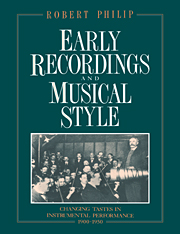5 - Woodwind vibrato
Published online by Cambridge University Press: 22 September 2009
Summary
INTRODUCTION
Woodwind-playing changed as much as string-playing in the first half of the twentieth century, and the growing use of vibrato was the most important development. As on stringed instruments, woodwind vibrato was part of a wider trend, which included changes to the instruments and to general playing styles. The metal flute came to predominate over the traditional wooden flute. Differences between oboes were less important, but the style of reed changed, in many cases becoming narrower and more flexible. The German bassoon was widely adopted. Changes to the clarinet were slight, and the clarinet is the only woodwind instrument on which vibrato did not become a widespread habit by the 1940s. On all woodwind instruments, however, there was a general tendency for phrasing to become more detailed in its nuances and wider in its dynamic range, to become more 'expressive', as the word is understood in the late twentieth century. By contrast, much of the woodwind-playing from the early part of the century is relatively plain in its phrasing. The presence or absence of vibrato played a major part in this development.
This chapter is divided into four sections: flute, oboe, clarinet, and bassoon. Each section begins with documentary evidence and then moves on to recordings. Because national styles are much more distinct in woodwind- than in string-playing in the first half of the century, recordings are arranged by country, in the order France, America, Britain, Germany and Austria, and other European countries.
- Type
- Chapter
- Information
- Early Recordings and Musical StyleChanging Tastes in Instrumental Performance, 1900–1950, pp. 109 - 140Publisher: Cambridge University PressPrint publication year: 1992



